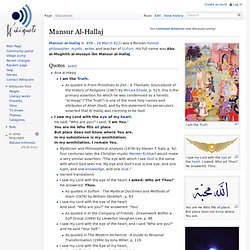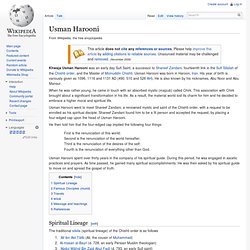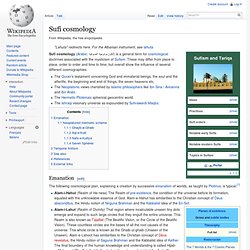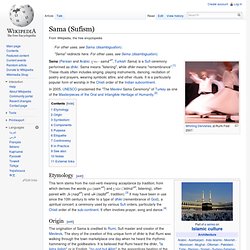

IBN AL-JAWZI. Mansur Al-Hallaj. Mansur al-Hallaj (c. 858 – 26 March 922) was a Persian monist philosopher, mystic, writer and teacher of Sufism.

His full name was Abu al-Mughith al-Husayn ibn Mansur al-Hallaj. Quotes[edit] I saw my Lord with the eye of the heart. I asked: Who art Thou? He answered: Thou. You are He Who fills all place But place does not know where You are. In my subsistence is my annihilation; In my annihilation, I remain You. Concealment does not veil Him His pre-existence preceded time, His being preceded not-being, His eternity preceded limit.
Sachal Sarmast. Al Hallaj. Al Hallaj Mystic and Martyr Al Halláj was a legendary Iranian Sufi master who lived in between 858 - 922 AD.

Al Hallaj was one of the earliest Sufi masters, he lead his life as a dervish wanderer, he would often go into trans where he felt one with all the creation, existence, with God. He once said "Ana al-haqq" ("I am the Truth"--i.e., God), something people at the time found offensive and could not understand, because of that. Al Hallaj was persecuted and found guilty of heresy. He found an unfortunate and brutal death (for further details please see Death of Al Hallaj). Sufism. Sufism (or taṣawwuf; Arabic: الصوفية) is a branch of Islam,[1] defined by adherents as the inner, mystical dimension of Islam; others contend that it is a perennial philosophy of existence that pre-dates religion, the expression of which flowered within Islam.[2] Its essence has also been expressed via other religions and metareligious phenomena.[3][4][5] A practitioner of this tradition is generally known as a ṣūfī (صُوفِيّ).

Sufis believe they are practicing ihsan (perfection of worship) as revealed by Gabriel to Muhammad: "Worship and serve Allah as you are seeing Him and while you see Him not yet truly He sees you". Sufis consider themselves as the original true proponents of this pure original form of Islam. Sufism is opposed by Wahhabi and Salafist Muslims.
Classical Sufis were characterised by their attachment to dhikr, (a practice of repeating the names of God, often performed after prayers)[19] and asceticism. Etymology[edit] Fanaa (Sufism) Fanaa (Arabic: فناء fanāʾ ) is the Sufi term for "passing away" or "annihilation" (of the self).[1] Fana represents a breaking down of the individual ego and a recognition of the fundamental unity of God, creation, and the individual self.[1] Persons having entered this enlightened state obtain awareness of the intrinsic unity (Tawhid) between Allah and all that exists, including the individual's mind. It is coupled conceptually with baqaa, subsistence, which is the state of pure consciousness of and abidance in God. The state of Fana is represented by Rumi in Book Six of the Masnavi where he writes: When the Shaykh (Halláj) said ‘I am God’ and carried it through (to the end), he throttled (vanquished) all the blind (sceptics).When a man's ‘I’ is negated (and eliminated) from existence,then what remains?
Usman Harooni. Khwaja Usman Harooni was an early day Sufi Saint, a successor to Shareef Zandani, fourteenth link in the Sufi Silsilah of the Chishti order, and the Master of Moinuddin Chishti.

Usman Harooni was born in Haroon, Iran. His year of birth is variously given as 1096, 1116 and 1131 AD (490, 510 and 526 AH). He is also known by his nicknames, Abu Noor and Abu Mansur. When he was rather young, he came in touch with an absorbed mystic (majzub) called Chirk. This association with Chirk brought about a significant transformation in his life. Usman Harooni went to meet Shareef Zandani, a renowned mystic and saint of the Chishti order, with a request to be enrolled as his spiritual disciple.
Imam al-Haddad. Imam Abd Allah ibn Alawi al-Haddad born in 1634 CE (1044 Hijri).

He lived his entire life in the town of Tarim in Yemen’s Valley of Hadramawt and died there in 1720 CE (1132 Hijri). In Islamic history, he was considered one of the sages. He was an adherent to the Ashari Sunni Creed of Faith (Aqeedah), while in Islamic jurisprudence (Fiqh), he was a Shafii. In spite of being a source of reference among the Sunni Muslims, only recently have his books began to receive attention and publication in the English speaking world.
Their appeal lies in the concise way in which the essential pillars of Islamic belief, practice, and spirituality have been streamlined and explained efficiently enough for the modern reader. Life[edit] Manzil. For the convenience of people who wish to read the Qur'an in a week the text may be divided into 7 portions, each portion is known as Hizb or Manzil.[1] The following division to 7 equal portions is by Hamza Al-Zayyat (d.156/772):[1] In Sufism[edit] Sufi's spiritual journey is seen as a path marked by various stopping places or stages. Naqshbandi. Naqshbandi (an-Naqshbandiyyah, Nakşibendi, Naksibendi, Naksbandi) is a major spiritual order of Sunni Islam Sufism.

It is the only Sufi way that traces its spiritual lineage to the Islamic prophet Muhammad, through Abu Bakr, the first Caliph and Muhammad's companion. Some Naqshbandi orders trace their lineage through Ali,[1] Muhammad's cousin, son-in-law and the fourth Caliph, in keeping with most other Sufi paths.[2][3] Spiritual lineage criteria[edit] In Sufism, as in any serious Islamic discipline such as jurisprudence (fiqh), Quranic recital (tajwid), and hadith, a disciple must have a master or sheikh from whom to take the knowledge, one who has himself taken it from a master, and so on, in a continuous chain of masters back to Muhammad. According to Carl W. Muraqaba. Muraqaba (Arabic: مراقبة) is the Sufi word for meditation.

Literally it is an Arabic term which means "to watch over", "to take care of", or "to keep an eye". It implies that with meditation, a person watches over or takes care of his spiritual heart (or soul), and acquires knowledge about it, its surroundings, and its creator.[1] Sufi whirling. In the symbolism of the Sema ritual, the semazen's camel's hair hat (sikke) represents the tombstone of the ego; his wide, white skirt (tennure) represents the ego's shroud.

By removing his black cloak (hırka), he is spiritually reborn to the truth. At the beginning of the Sema, by holding his arms crosswise, the semazen appears to represent the number one, thus testifying to God's unity. While whirling, his arms are open: his right arm is directed to the sky, ready to receive God's beneficence; his left hand, upon which his eyes are fastened, is turned toward the earth. The semazen conveys God's spiritual gift to those who are witnessing the Sema. Revolving from right to left around the heart, the semazen embraces all humanity with love.
Sufi cosmology. Sufi cosmology (Arabic: الكوزمولوجية الصوفية) is a general term for cosmological doctrines associated with the mysticism of Sufism.

These may differ from place to place, order to order and time to time, but overall show the influence of several different cosmographies: The Quran's testament concerning God and immaterial beings, the soul and the afterlife, the beginning and end of things, the seven heavens etc.The Neoplatonic views cherished by Islamic philosophers like Ibn Sina / Avicenna and Ibn Arabi.The Hermetic-Ptolemaic spherical geocentric world.The Ishraqi visionary universe as expounded by Suhrawardi Maqtul. Emanation[edit] The following cosmological plan, explaining a creation by successive emanation of worlds, as taught by Plotinus, is typical:[1] Sema. Sama (Persian and Arabic: سَمَاع - samā‘un, Turkish Sama) is a Sufi ceremony performed as dhikr.

Shah Waliullah. Qutb-ud-Dīn Ahmad ibn 'Abdul Rahīm (Arabic: قطب الدین احمد ابن عبدالرحیم), better known as Shāh Walīullāh (1703–1762 CE / 1114–1176 AH) was an Islamic scholar, reformer and founder of modern Islamic thought who attempted to reassess Islamic theology in the light of modern changes.[1][2] Life[edit] Shāh Walīullāh was born in 1703, four years before the death of Mughal emperor Aurangzeb. Sarkar Sabir Pak. Sufi metaphysics. Sufi psychology. Nafs. Tijaniyyah. Haqiqa. Maqaam. Maqaam (also known as maqām) or maqaamat (plural), translating to "stations" in Arabic, is a term that references the various stages a Sufi's soul must attain in its search for God.[1] The stations are derived from the most routine considerations a Sufi must deal with on a day to day basis and is essentially an embodiment of both mystical knowledge and Islamic law (Sharia).
Shadhili. Ni'matullāhī. Jubai. Bushaq At'imah, "The Gastronomer" Bushaq could not help poking fun at Sufism, as this one example from his "glossary" (farhang) reveals: Haal. Fariduddin Ganjshakar. Qadiriyyah. Sulook. Nimat Allah al-Harawi. Rifa'i.